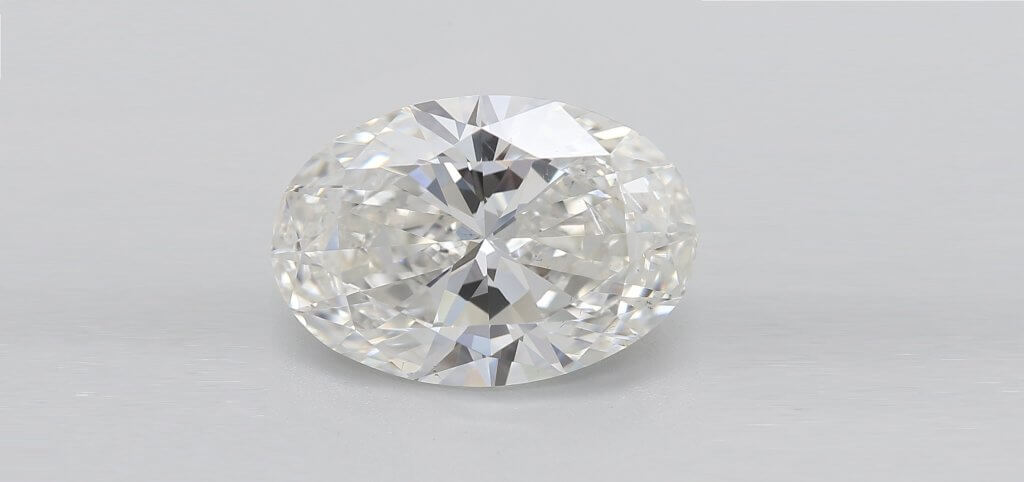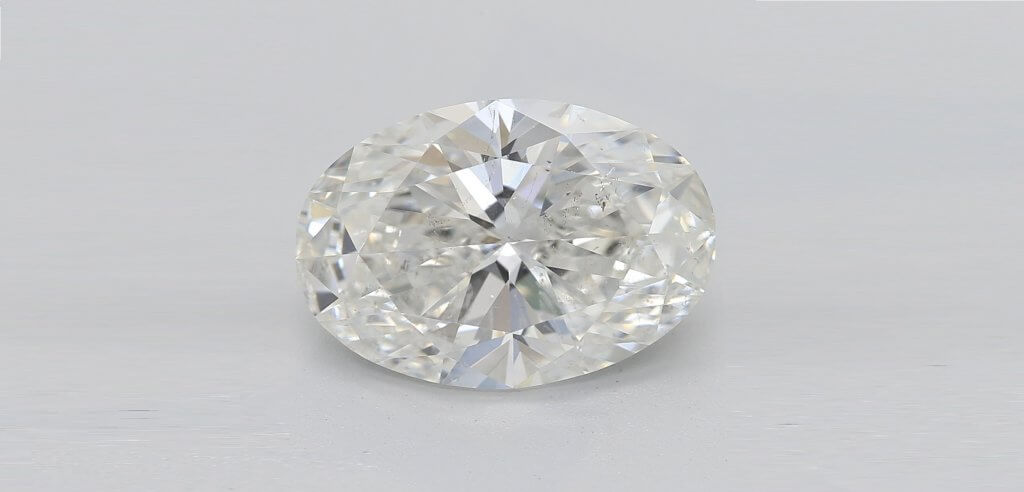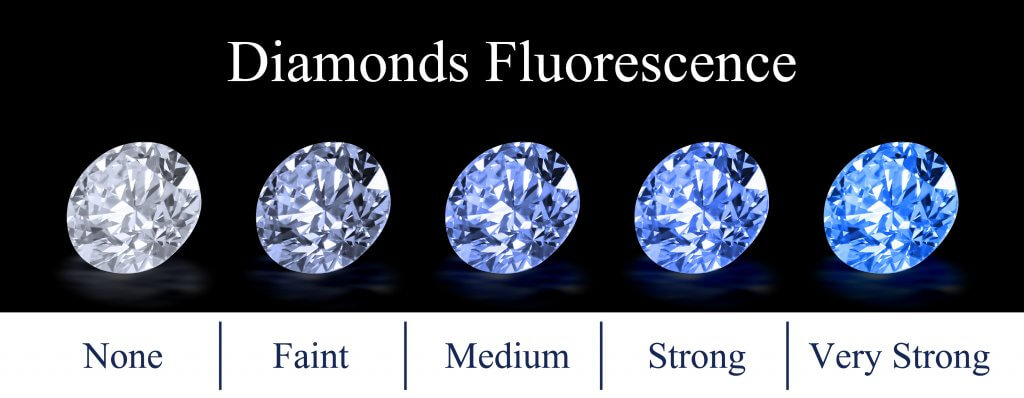H Color Diamonds: The Ins And Outs
Key Takeaways
- The most important thing to realize when looking for that perfect diamond is that most diamonds are a pretty long way from perfection.
- It’s about weighing up the options, picking the right faults and the right advantages, and walking away with something that looks perfect, without the high price tag.
- The H grade is a good example of this, and why you do not need to aim for the very top of the grading system.
- It is affordable, but most H diamonds will exhibit no noticeable color. Particularly large diamonds may be a little less ‘safe’ at an H grade, but most shoppers will find a great option at this level.

One of the things that makes diamonds so appealing to us, aside from their incredible sparkle, is the fact that something so perfect could be formed so many miles underground, and over the course of so many billions of years, and under conditions as inhospitable and ferocious as they are deep down in the earth’s mantle.
However, most diamonds are actually a pretty long way from perfection – although you wouldn’t always know it to look at them.
Aside from a very small (and very valuable) handful of diamonds, these stones feature internal cracks, crystals, and marks – and trace amounts of other substances which negatively impact their appearance, whether this happens on the microscopic level, or in a way that we can all see without special equipment.
This certainly works to our favor when we’re shopping, since truly flawless diamonds are incredibly valuable – and far too valuable for most of us to consider choosing for our engagement rings, unless we’re working with a bottomless budget.
Understanding how to pick a diamond with just the right kind of faults and flaws is not always straightforward, but it’s absolutely possible – and, in all likelihood, not quite as tricky as you expect. Whether you’re thinking about clarity or color, there are always choices.
The H color grade is a prime example of this.
- The Color Grade
- What is H Quality Diamond?
- Is an H Color Diamond Good?
- Is I Better Than H in Diamonds?
- Is G Better Than H in Diamonds?
- Do H Diamonds Sparkle?
- What Color Should a Diamond Sparkle?
- When Should You Pick an H Color Diamond?
- Are H Diamonds Common?
- Can You Enhance the Color of a Diamond?
- H Color and Price
- How Much is an H Diamond Worth?
- Our Summary
The Color Grade
Chances are, you’ve come here looking for a clear diamond for your engagement ring – though you might still be new to the idea that the world of diamonds is not divided into two separate categories, with one for clear diamonds and the other for fancy color diamonds. This is one of the most important things first-time shoppers learn since it will help them to avoid disappointment after the ring has been made: even clear diamonds have color.
What is H Quality Diamond?
H is one of the color grades used by the GIA to demonstrate how close to (or, alternatively, how far from) colorless a diamond is, with very minor variations between each consecutive grade.
Almost all clear diamonds feature some ‘color’ – a yellow or brownish tint caused by the presence of a very small amount of nitrogen, which is an entirely natural occurrence that takes place during the part of the diamond’s life cycle that takes part deep underground. It cannot be removed or ‘fixed’, and can be so mild as to only be visible under strong magnification and specialized lighting.
It can also be mild enough that, when it has been mounted within a ring setting and placed on the finger, it’s totally unnoticeable.
It can, however, be strong enough to be clearly visible within the diamond, and, as a result, to totally undermine an otherwise beautiful stone or piece of jewelry.
This is why the color scale is so important. As you can see below, the difference between diamonds that are totally free from color, and those that are way down at the far end of the scale, is pretty clear to see:

The scale begins at D, meaning that the H color grade is the fifth in the scale – and a part of a category of diamonds referred to as ‘Near Colorless’.
Is an H Color Diamond Good?
Yes, an H color diamond sits in a great position between grades that afford an extremely high price on the market, and grades that will bring down the beauty of your ring.
Color is seen as a highly undesirable trait in clear diamonds. Sure, plenty of people – celebrities in particular – enjoy the bright or subtle pinks, blues, reds, oranges, and greens of fancy colored diamonds, but those are graded according to entirely different scales – and are definitely something of an acquired taste in engagement rings.
So, for most of us, everything rests on the clear diamond.
Unfortunately, most diamonds fall short of the very highest color grades. A little yellow tint within clear diamonds is incredibly common, which means that the very rarest stones – those with no color at all – are worth thousands of dollars more to collectors.
Fortunately, there are a few grades that separate the totally clear diamonds from those that are yellow enough to actually appear yellow to the naked (and untrained) eye – and H is one of them.
H is just two grades away from the Colorless grades, which means that, while these diamonds definitely feature some color, it will be far too subtle to impact on the diamond’s beauty outside of the lab.
Is I Better Than H in Diamonds?
No, H is slightly clearer than I according to the GIA’s color scale, although the difference between them is not something we would be able to spot without the proper equipment.
Is there any real difference between the two? Yes, and one that is tangible enough for expert graders to recognize. Is there any visual difference between the two, provided you’re away from the bright lights of the lab and the strong magnification tools used by the graders? Not one that any of us would be able to spot.
Even under magnification, the average shopper would struggle to spot the difference – unless you were shown an H diamond alongside one with a much higher color grade.
As a result, I diamonds will be a little more affordable than H diamonds – provided, of course, that they are of otherwise comparable quality in terms of cut and clarity, and the same carat weight. The difference will likely be a few hundred dollars, meaning that both of these color grades are great ones to watch if you’re looking to get the best diamond within your price point.
Is G Better than H in Diamonds?
Yes but, again, only marginally. Also important to consider is the fact that G holds a pretty favorable position on the market.
Most diamond shoppers, after they’ve done their research on the Four Cs, will make the decision to focus on the Near Colorless range of color grades. There, you’ll not only find more choice (since colorless diamonds are a rarity), but you’ll also get a lot more value for your investment, since you won’t be paying for features that are invisible to the naked eye.
So, in theory, that makes the G grade – the highest of the Near Colorless grades – an ideal spot to aim for, right?
In a sense, yes. G color diamonds will be the clearest of all the diamonds in this category, and sticking to this grade pretty much guarantees you a diamond that appears totally clear, however big it is – or whatever shape.
Still, as the ‘best’ Near Colorless grade, G diamonds enjoy a premium price of their own – although nowhere near as high as a Colorless diamond.
As a result, however, it can pay to keep an open mind and look at diamonds with color grades of H and I, too. That way, you can ensure you’re maximizing your investment in this area.
Do H Diamonds Sparkle?
Yes, since cut quality and diamond shape are responsible for sparkle.
You won’t notice any difference in sparkle between an H and a D diamond unless those diamonds differ on cut quality – or shape. A diamond’s depth and table, for instance, matter a lot more than color when it comes to sparkle.
What’s more, there are diamond cuts that sparkle more than others. An Excellent cut D color Emerald diamond won’t sparkle quite like an Excellent cut H color Round diamond, since the round cut enjoys the ideal facet-structure and proportions to create a truly spectacular light performance, even if it does feature a little more color than the Emerald cut.
When Should You Pick an H Color Diamond?
Never before seeing the diamond in person, or researching how the shape and size of your diamond can impact the presence of color.
It’s not uncommon for first-time diamond shoppers to get so caught-up on color that they start to convince themselves it’s obvious, even when they’re looking at a G or H color diamond. Although the color grades are there to help up, a certain amount is left open to interpretation, since we know that some diamond shapes accommodate a little color (without actually showing it) better than others.
What does this mean? It means that, in a nutshell, a shopper looking at 1 carat Round diamonds could have a pretty easy time finding a great stone in the H color grade, while a shopper looking at 1 carat Emerald diamonds could have a much tougher time, despite the fact that the diamonds they’re looking at have been graded the same.
As you’ve probably guessed, then, Round diamonds hide color pretty well. The Pear and Marquise cut, however, are a little less forgiving, with both cuts tending to show their color more than the Round cut – particularly toward the sharp points that make them so distinctive.
This is difficult to cover, since most settings are designed to complement the sharp point of the Marquise or Emerald, rather than hide it, but a yellow or rose gold setting can downplay a slightly yellow tint.
An H color grade could still be a great choice, unless you’re picking a particularly large diamond.
The Emerald and Radiant cuts, however, tend to reflect color from their centers, making it harder to ‘disguise’ any yellow within the setting. An H color grade can still work, particularly if you’re looking at modestly-sized diamonds – or planning on using a gold setting, rather than platinum.
Are H Diamonds Common?
Yes, they represent one of the most popular color grades among shoppers today, and for good reason.
Most shoppers will stick to the H-I range, with some opting to go as high as G. But, as we mentioned above, Near Colorless diamonds are far easier to find, far more cost-effective, and, as a result, far more popular among shoppers. You won’t struggle to find them on the market.
The reason behind this is pretty much as the same reason why shoppers stick to the slightly lower clarity grades, such as VS1 and VS2, SI1 and, at times SI2.
Yes, you might be able to work a very modestly sized VVS1 E colored diamond into your price range, but you’ll get a much bigger and more impressive diamond (still free from any visible color of flaws) if you’re confident enough to experiment with the lower grades.
H Color and Price
You ideal color grade will allow you to pay for visual quality, rather than invisible quality. So, is an H diamond an affordable grade?
How Much is an H Diamond Worth?
A one carat H color Round diamond could cost anywhere from $4,000 – any less, and you would likely struggle to find an eye clean diamonds.
Diamond prices are a complex subject in their own right, since they not only depend on the cut, color, carat weight and clarity of the diamond, but also its fluorescence, whether or not it features hearts and arrows, and its shape, too.
Throw in the fact that price per carat increases with diamond size – for instance, the price per carat of a six carat diamond will be higher than it is for a one carat diamond – and giving you a rough, guideline price for a diamond of any color is pretty difficult.
Instead, it can be helpful to understand quite how much you are able to save by focusing on the H color grade. For starters, dipping down from the Colorless grades can easily save you around 40% on diamonds of the same size, clarity grade and cut quality.
The price difference between a G color and an H color diamond will be smaller, but some fluidity between these two grades is pretty useful when you’re looking for that one perfect diamond.
Our Summary: Should You Buy an H Color Diamond?
It’s definitely a grade worthy of your consideration. It could be the perfect choice for you – and, for many shoppers, it is. But there are things to keep in mind.
The average carat weight for a diamond engagement ring is around 1 carat, and the most popular diamond shape for engagement rings is, of course, still the Round cut. It stands to reason, then, that the H color grade will represent one of the most popular color grades out there, since, for so many shoppers, it offers plenty of choice for beautiful, clear diamonds at a much more affordable price point than Colorless diamonds.
Nevertheless, there are some exceptions to this diamond’s popularity – exceptions that you’ll only ever spot once you go to see them in person.
Don’t rule out the H color grade just because you’re interested in two carat diamonds rather than one carat diamonds, or the Emerald cut rather than the Round cut. It goes with the territory that any diamond at this grade will feature some color, but also that each diamond’s appearance outside of the lab is going to be unique.
The color grades are there to indicate the quality and value of a diamond, but the H color grade is proof that you certainly don’t need to aim for the very top of the color scale just to get a beautiful diamond – and it could be an ideal choice for you, as it is for so many shoppers. See it for yourself, and you might just find the ideal diamond.

Jul 18, 2022 By Willyou.net
What You Didn’T Know About I Color Diamonds

Jul 18, 2022 By Willyou.net
What You Don’T Know About K Color Diamonds








